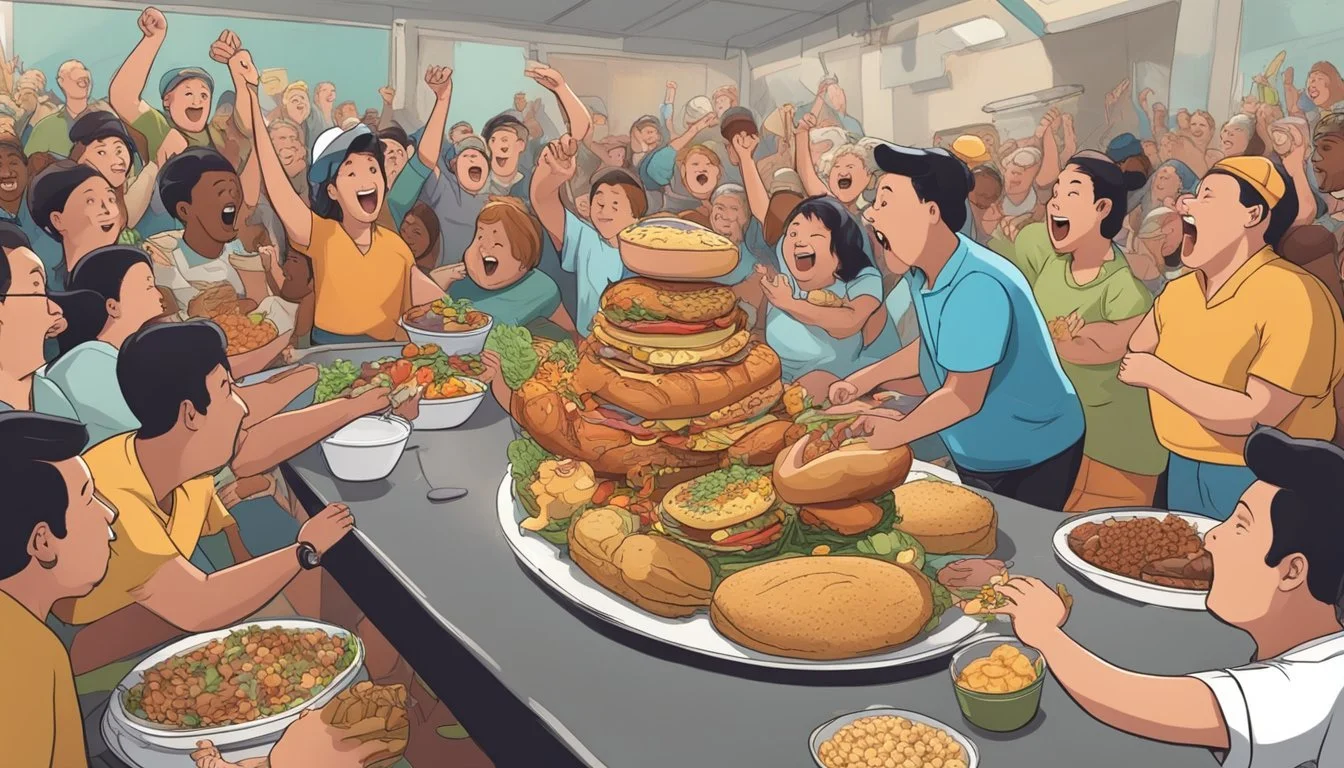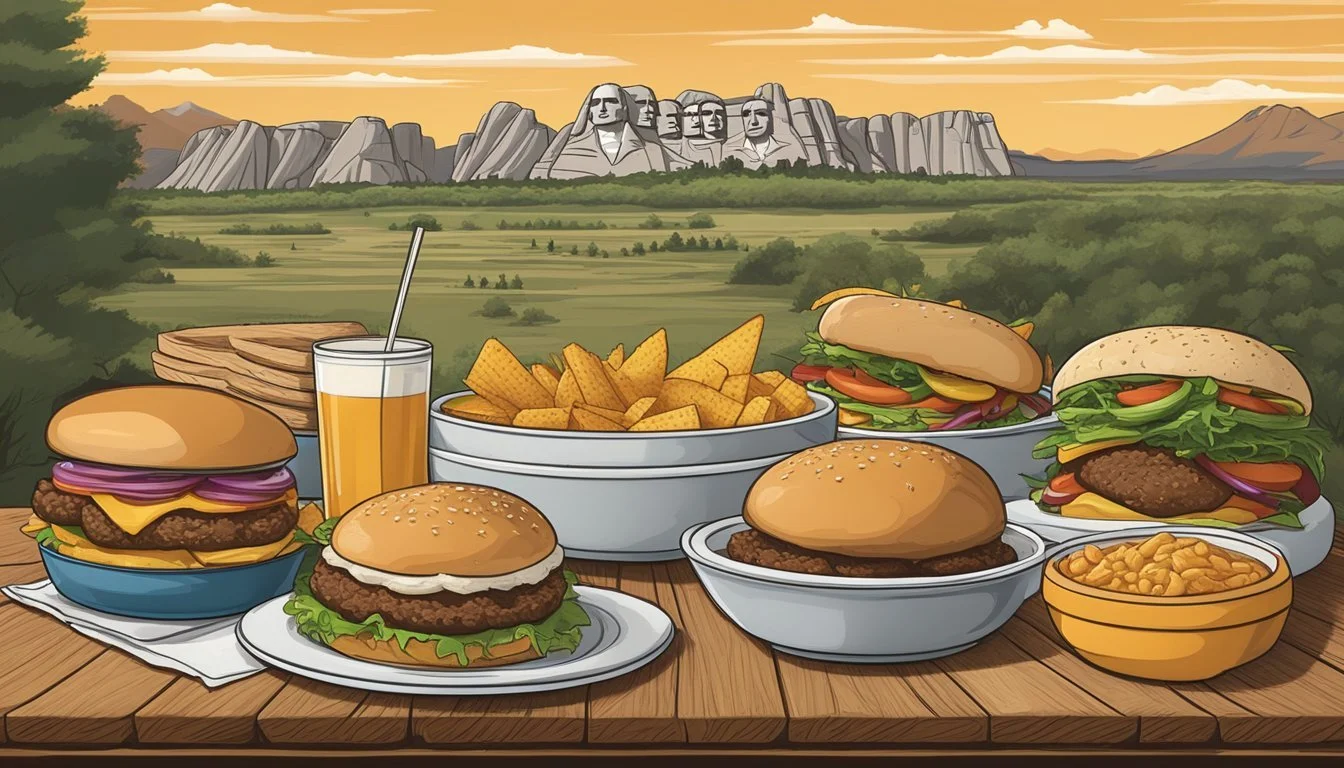South Dakota Food Challenges
Top Eating Contests to Test Your Limits
South Dakota offers a unique array of food challenges for those who are interested in testing their eating abilities. From carnivorous feasts to colossal pizzas, the state presents a diverse selection of gastronomic feats for locals and travelers alike. These daring culinary contests not only provide an opportunity to try regional favorites but also offer the thrill of competition. They are a testament to local eateries' creativity and South Dakota's hearty food culture.
One might find themselves tackling a mountain of chislic, South Dakota's official nosh, at Urban Chislic in Sioux Falls, where participants dive into a 100-ounce serving complete with a variety of side dishes. Alternatively, the grandeur of Beau Jo's Grand Sicilian Pizza Challenge invites competitors in Rapid City to consume a mammoth pizza loaded with toppings within a tight timeframe. These eating contests are designed to push the boundaries of appetite and endurance, often rewarding triumphant eaters with prizes, cash, or simply the glory of having their names etched on a wall of fame.
It is not just about the glory, as these food challenges often draw attention to the local businesses hosting them, creating a community event that brings together patrons eager to cheer on the participants. South Dakota's food challenges are more than just about eating; they are a celebration of local cuisine and the spirit of adventure that defines the state's dining scene.
Overview of South Dakota's Culinary Landscape
South Dakota's culinary identity is deeply intertwined with its agriculture, local ingredients, and historical influences. The state's cuisine is a reflection of its abundant resources and heritage.
Popular Local Ingredients
Beef: A staple in South Dakota, beef is widely used across the state due to the extensive cattle ranching within the region.
Pork: Similarly, pork is another prominent feature in South Dakota dishes, often sourced from local farms.
Lamb: While less common than beef or pork, lamb is a cherished ingredient, particularly in traditional recipes.
Produce: Seasonal produce such as corn plays a significant role in accompanying meat-centric dishes in South Dakota.
Traditional South Dakota Dishes
Chislic: This traditional dish consists of cubed red meat, typically lamb, beef, or venison (What wine goes well with venison?), deep-fried and served with a variety of dipping sauces.
Bison (What wine goes well with bison?): Bison meat is recognized for its leaner quality in comparison to beef and is found in numerous local dishes.
Fry bread: A legacy from Native American cuisine, fry bread is a versatile component, served alongside savory dishes or as a sweet treat.
Kuchen: As the state dessert, Kuchen showcases South Dakota's German-Russian heritage, often filled with prairie fruits.
Food Challenges in South Dakota
South Dakota offers a variety of food challenges for the adventurous eater. From colossal burgers to immense pizzas, these eating contests cater to those with a hearty appetite and a competitive spirit.
Boss Hog Challenge
Restaurant: Boss's Pizza & Chicken
Challenge: 28-inch pizza
Location: Sioux Falls (also Brookings, Keystone, Rapid City, Tea, and Yankton)
Time Limit: 1 hour
Details: Teams of two must finish a 28-inch pizza loaded with three toppings, two of which are meat, to win $200 in gift certificates. The meal is free if completed within the time limit.
Victory Lap Burger Challenge
Restaurant: Victory Lap Bar & Grill (Please note that the example URL provided is not a real link to a Victory Lap Challenge)
Challenge: 3 pound burger
Location: Sioux Falls
Time Limit: 1 hour
Details: Contestants must finish a massive 3 pound burger, complemented with sides, within an hour to have their meal comped and earn a spot on the restaurant's wall of fame.
Rock Bottom Burger Challenge
Restaurant: Rock Bottom Eatery (Please note that the example URL provided is not a real link to a Rock Bottom Challenge)
Challenge: Burger with multiple beef patties
Location: Sioux Falls
Time Limit: Variable
Details: Participants tackle a towering burger made up of several beef patties, cheese, and toppings. Completing the challenge often rewards the victor with the meal for free, and sometimes additional prizes.
Understanding Food Insecurity
Food insecurity in South Dakota affects individuals and families across every county. It involves a lack of consistent access to enough food for an active, healthy life, often impacting children and rural communities the hardest.
Impact of COVID-19 on Food Security
The COVID-19 pandemic significantly worsened food insecurity in South Dakota. Job losses and economic instability led to a surge in food insecurity, turning what was once a manageable situation for many families into a struggle for daily sustenance. Food banks experienced unprecedented demand, as families who had never relied on assistance found themselves in need.
The Role of Food Banks
Feeding South Dakota plays a crucial role in combating hunger and improving health outcomes. It operates as a critical source of food for thousands of individuals experiencing food insecurity, including a substantial number of children who are among the most vulnerable. During times of crisis, such as the COVID-19 pandemic, these institutions became lifelines for struggling families, working tirelessly to ensure that the increased demand for food aid was met.
Nutrition and Health Awareness
In South Dakota, the focus on nutrition and health awareness is advancing through informed dietary guidelines and community-led healthy eating programs. These initiatives promote a healthy life not only for individuals but also for families across the state.
Dietary Guidance from the USDA
The U.S. Department of Agriculture (USDA) provides comprehensive dietary guidelines that serve as a blueprint for nutritional health. They detail the importance of consuming a variety of fruits, vegetables, grains, protein foods, and dairy for a balanced diet. Following these recommendations can help South Dakotans maintain a healthy weight, reduce the risk of chronic disease, and foster overall well-being.
Fruits and Vegetables: A rainbow of colors to ensure a wide range of nutrients.
Grains: At least half of which are whole grains.
Protein: Lean meats, poultry, seafood, beans, legumes, and nuts.
Dairy: Low-fat or fat-free milk, yogurt, and cheese.
Local Healthy Eating Initiatives
South Dakota is taking strides in local healthy eating initiatives by implementing state-specific programs. These initiatives, supported by organizations such as the SDSU Extension, work towards increasing fruit and vegetable consumption, which is currently low compared to national averages. Through education and collaboration with local communities, South Dakotans of all ages are learning how to incorporate nutritious foods into their daily meals.
Educational Programs: Teaching South Dakotans about balanced menus and nutrition.
Community Outreach: Local health professionals engaging the public in nutrition education.
Youth Engagement: Instruction and activities that help young people make healthy eating choices early in life.
Supporting Community Growth
South Dakota's food challenges can be confronted through concerted efforts in Agricultural Development and providing comprehensive Support Programs and Services. These initiatives are pivotal for fostering robust communities, enhancing food security, and supporting the state's vibrant agricultural heritage.
Agricultural Development
South Dakota's agricultural development is integral to community growth. The increase in farmer's markets and community-supported agriculture (CSA) programs underscores a commitment to strengthening local food systems and promoting sustainability. As the traditional number of farms declines, initiatives that engage in the economic development of agriculture become essential.
Support Programs and Services
Services aimed at combating food insecurity operate across South Dakota. Organizations like Feeding South Dakota are a lifeline to many, providing necessary sustenance and community support. Aligning food resources and closing hunger gaps are among the critical actions conducted by entities such as Sioux Falls Thrive. These services, often supported by the USDA, provide not only food but also educational and logistical assistance to ensure sustainable community support.
Challenges Facing Rural and Urban Areas
In South Dakota, the issues of food accessibility and stability greatly differ between rural and urban settings, each facing unique barriers. These challenges stem significantly from transportation difficulties and housing security, impacting the state's ability to ensure consistent food access for all residents.
Transportation and Access to Food Outlets
In rural regions, limited public transportation options severely hinder residents' ability to reach food distribution hubs, a problem that has been exacerbated by winter storms. With an average of 120 food distributions planned monthly, cancellations due to inclement weather leave rural populations particularly vulnerable. As stated by Dakota News Now, such disruptions cause significant strain on communities that heavily depend on reliable food supply services.
Conversely, urban areas, though better connected, confront the challenge of distance to diverse and affordable outlets. While transportation may be more readily available, the concentration of food stores often does not align with the distribution of low-income housing, creating pockets of limited access known as food deserts.
Housing and Food Stability
Housing security in South Dakota's urban areas correlates directly with food stability. Urban residents, especially those in low-income brackets, may face higher living costs, leaving less disposable income for nutritious food options. Conversely, rural populations often deal with the nuances of geographic isolation, which can lead to lower access to stable food sources.
In the case of housing, the struggle crosses the urban-rural divide. Counties may lack the infrastructure to support growth or face declines due to economic shifts, such as those observed in the agriculture industry. Small towns in particular, according to South Dakota News Watch, are coping with such changes during the pandemic, the effects of which link directly to residents' food security and stability.






